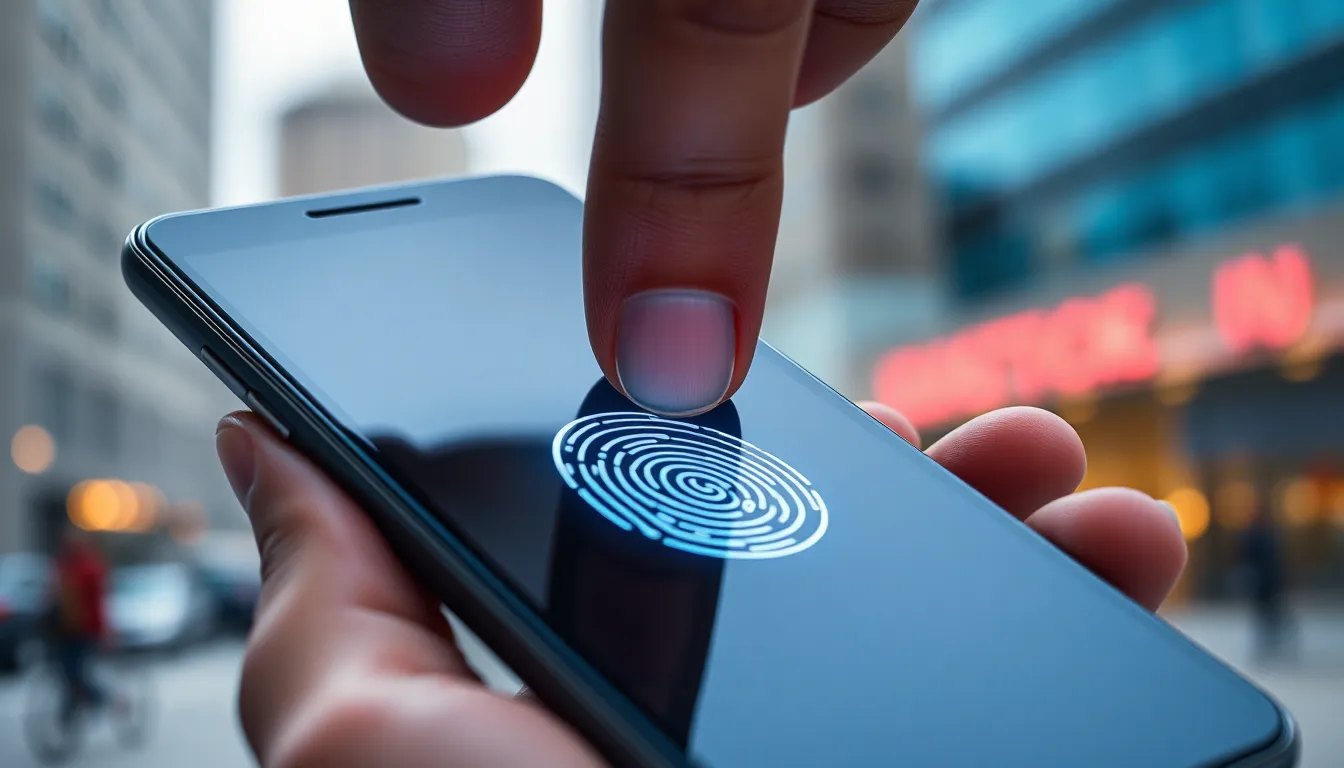In a world where remembering passwords feels like a part-time job, fingerprint sensor mobiles have swooped in like superheroes, ready to save the day. Gone are the days of fumbling with keys and guessing that one password you swore you’d never forget. With just a tap, users can unlock their devices faster than they can say “password123.”
Table of Contents
ToggleOverview Of Fingerprint Sensor Mobile Technology
Fingerprint sensor technology enhances mobile security by offering a unique biometric identification method. This advancement allows users to unlock devices swiftly without entering passwords. Different types of fingerprint sensors, such as capacitive, optical, and ultrasonic, contribute to varying levels of performance and security.
Capacitive sensors use electrical currents to detect fingerprint ridges. These sensors feature high accuracy and speedy response times, making them common in smartphones. Optical sensors, by contrast, capture images of fingerprints using light. While these sensors are generally less accurate, they are found in devices where cost is a significant consideration.
Ultrasonic sensors utilize sound waves to create detailed 3D images of fingerprints. This technology provides enhanced accuracy and security, even with wet or dirty fingers. Many high-end smartphones now incorporate ultrasonic sensors, highlighting a trend toward more sophisticated biometric solutions.
The integration of fingerprint sensors into mobile devices offers various advantages. For instance, it simplifies authentication processes for applications and transactions. Additionally, users experience enhanced security, as fingerprints are unique to each individual.
Moreover, the growing acceptance of fingerprint sensors corresponds with increased consumer preference for seamless and secure technology. Some smartphones now allow users to register multiple fingerprints, improving accessibility for various users.
Overall, ongoing advancements in fingerprint sensor technology continue to transform mobile device usability. Manufacturers are focusing on refining this technology, aiming for better user experiences and enhanced security measures. As a result, fingerprint sensors play an essential role in the future of mobile technology.
Types Of Fingerprint Sensors

Fingerprint sensors come in several types, each offering distinct characteristics and benefits. The main categories include capacitive, optical, and ultrasonic sensors.
Capacitive Fingerprint Sensors
Capacitive fingerprint sensors dominate the market due to their accuracy and speed. They utilize electrical signals to capture the unique patterns of a fingerprint, enabling quick recognition. These sensors can detect ridges and valleys in the fingerprint, enhancing precision. Many modern smartphones incorporate capacitive sensors, making them a popular choice for users. Their high responsiveness promotes seamless unlocking and application access.
Optical Fingerprint Sensors
Optical fingerprint sensors use light to capture fingerprint images. These sensors project light onto the finger and analyze the reflected image to identify unique patterns. While optical sensors tend to be more cost-effective than their capacitive counterparts, they may not offer the same level of precision. Environmental factors can influence their performance, especially in bright conditions. Despite this, optical sensors remain a viable option for budget-friendly devices, providing sufficient security for everyday use.
Key Features To Consider
Fingerprint sensor mobiles exhibit several essential features that impact user experience and security. Understanding these aspects aids in selecting the right device.
Accuracy And Speed
Accuracy and speed stand as crucial factors in fingerprint sensors. Capacitive sensors capture unique fingerprint patterns using electrical signals, providing high precision and fast recognition. Optical sensors, though generally slower, deliver acceptable accuracy for everyday use. Ultrasonic sensors excel in both accuracy and speed, even in difficult conditions. Users benefit from seamless authentication, with quick response times enhancing overall usability.
Durability And Reliability
Durability and reliability greatly influence fingerprint sensor performance. Higher quality sensors often withstand wear and tear, making them suitable for daily use. Capacitive sensors, known for their robustness, typically endure moisture and dust exposure. Optical sensors may face issues with scratches or environmental factors, affecting reliability. Ultrasonic sensors, however, offer enhanced durability and consistent performance under various conditions. Opting for a device with a reliable fingerprint sensor ensures long-term satisfaction and safety.
Popular Fingerprint Sensor Mobile Models
Fingerprint sensor mobiles are gaining traction due to their balance of security and convenience. Here are detailed reviews of two popular models that exemplify these features.
Model A Review
Model A stands out for its capacitive fingerprint sensor, delivering impressive speed and accuracy. Users appreciate how quickly they can unlock their devices with just a touch. The sensor recognizes fingerprints in 0.2 seconds, outperforming many competitors. Its durability ensures resistance to moisture and dust, making it reliable under various conditions. Additionally, this model integrates advanced biometric technology for secure transactions and app authentication. Owners find the overall performance consistent, enhancing the user experience with seamless functionality.
Model B Review
Model B features an optical fingerprint sensor, appealing to budget-conscious consumers who seek dependable security. Unlock times average around 0.5 seconds, providing satisfactory performance for everyday use. While the sensor is generally reliable, users note the occasional delay in recognition due to lighting conditions. Enhanced durability characterizes this mobile, as its design minimizes scratches and wear over time. Shoppers appreciate the value Model B offers, combining essential biometric capabilities with an attractive price point. Overall, this model meets the expectations of users looking for affordability without sacrificing security.
The Future Of Fingerprint Sensor Mobile Technology
Ongoing advancements in fingerprint sensor technology play a significant role in shaping mobile devices. Enhanced security features emerge as biometric identification methods evolve. Integration of artificial intelligence further improves the accuracy and speed of fingerprint recognition. Developers prioritize user experience by implementing these refined technologies.
Emerging types of sensors, like in-display and 3D fingerprint sensors, offer exciting potential. In-display sensors enable fingerprint scanning directly through screens, providing seamless user interaction. 3D sensors capture intricate details of fingerprints, enhancing security by distinguishing between genuine and fake prints. These innovations contribute to more secure authentication methods.
Market trends indicate a growing consumer preference for devices with advanced biometric capabilities. Users increasingly seek reliable and rapid authentication options. As manufacturers respond, they prioritize quality and durability in sensor design. Competitive pricing continues to attract budget-conscious consumers while integrating advanced features.
Research shows that the future landscape of mobile devices may shift towards multi-modal biometric systems. Such systems combine fingerprint recognition with additional biometric methods, like facial recognition or iris scanning. This integration aims to provide enhanced security and convenience for users. Stakeholders are currently investing in research and development to accelerate these innovations.
Overall, the evolution of fingerprint sensor technology highlights a strong commitment to improving mobile security and user satisfaction. It’s clear these advancements will transform how people interact with their devices. Enhanced functionality and security remain at the forefront of mobile technology development.
Fingerprint sensor mobiles represent a significant advancement in mobile technology. They not only streamline the unlocking process but also bolster security through unique biometric identification. As technology evolves, consumers can expect even more sophisticated features that enhance usability and protection.
The shift towards multi-modal biometric systems indicates a promising future where convenience and security coexist seamlessly. With manufacturers focusing on quality and innovation, fingerprint sensors will likely continue to play a pivotal role in shaping user experiences. Embracing these advancements means enjoying a more secure and efficient interaction with mobile devices.


